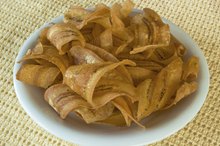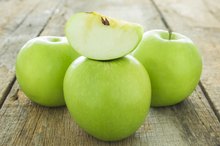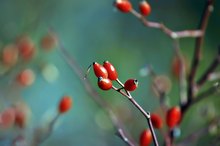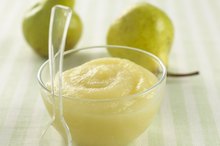How to Reconstitute Dried Fruit
Reconstituting dried fruit restores its texture and gives better results for certain recipes, such as sauces and pies. Reconstituting refers to adding moisture to the dried fruit. This reverses the dehydrated state and makes the fruit softer. The process of returning moisture to dried fruit is also called refreshing the fruit. Using the right amount of water to refresh fruit will retain its flavor and make it juicy without sogginess.
Dried Fruit Basics
The traditional method for drying fruit is to dry it in the sun. It can also be dried in an industrial or home oven, or in a food-dehydrating appliance. Removing moisture from foods protects it from spoiling, because moisture allows microorganisms to grow. Blanching light-colored fruits by steaming them in a double boiler helps to keep them from darkening when they dry. Dried fruit retains the same nutritional value as fresh fruit, although a small loss of vitamin C can occur from blanching, according to the Washington State University website.
- The traditional method for drying fruit is to dry it in the sun.
- Dried fruit retains the same nutritional value as fresh fruit, although a small loss of vitamin C can occur from blanching, according to the Washington State University website.
Dried Fruit in Baking
How to Dehydrate Bananas in a Food Dehydrator
Learn More
A recipe calling for four fresh apricots would require eight reconstituted dried half apricots. Reconstituting them will give the apricots their original size and moisture, so that the recipe will turn out correctly. Generally, 1 cup of dried fruit will make approximately 1 1/2 cups of reconstituted fruit, according to the Virginia Cooperative Extension 1. In certain recipes, it isn't necessary to reconstitute dried fruit because the recipe has enough moisture to cause the dried fruit to plump up during cooking or baking, such as a moist stuffing for turkey made with dried cranberries, or adding raisins to oatmeal cookies.
- A recipe calling for four fresh apricots would require eight reconstituted dried half apricots.
- In certain recipes, it isn't necessary to reconstitute dried fruit because the recipe has enough moisture to cause the dried fruit to plump up during cooking or baking, such as a moist stuffing for turkey made with dried cranberries, or adding raisins to oatmeal cookies.
Reconstituting Dried Fruit
Reconstituting dried fruit may take from one to eight hours depending on the type of fruit, the size of the pieces and the water temperature. Using hot water speeds up the process, and smaller pieces of fruit reconstitute more quickly than large pieces. The basic method is to put the dried fruit in a container and add enough water to just cover the fruit. Using too much water can cause a loss of flavor. Keep the fruit in the refrigerator while soaking it to prevent the growth of microorganisms. If the fruit absorbs all the water before it plumps up to full size, add more water. Fruits usually need 150 percent to 200 percent more water to refresh them.
- Reconstituting dried fruit may take from one to eight hours depending on the type of fruit, the size of the pieces and the water temperature.
- If the fruit absorbs all the water before it plumps up to full size, add more water.
Dried Fruit Tips
What Causes Fruits to Mold?
Learn More
To reconstitute dried fruit for use in hot cereal, cut the fruit into bite-sized pieces and simmer it in the cooking water for 1 or 2 minutes before adding the cereal. To reconstitute fruit for a recipe that calls for sugar, wait until the fruit has fully plumped up from soaking before adding the sugar. Adding sugar too soon can make the fruit tough. Reconstitute only as much dried fruit as you plan to use. Although dried fruit resists spoiling, once water is added it can spoil quickly.
- To reconstitute dried fruit for use in hot cereal, cut the fruit into bite-sized pieces and simmer it in the cooking water for 1 or 2 minutes before adding the cereal.
- To reconstitute fruit for a recipe that calls for sugar, wait until the fruit has fully plumped up from soaking before adding the sugar.
Related Articles
References
- Virginia Cooperative Extension: Using Dehydration to Preserve Fruits, Vegetables and Meats
- University of Missouri Extension: Quality for Keeps: Food Preservation—How to Use Dried Foods
- Rizkalla SW. Health implications of fructose consumption: A review of recent data. Nutr Metab (Lond). 2010;7:82. doi:10.1186/1743-7075-7-82
- Du H, Li L, Bennett D, et al. Fresh fruit consumption in relation to incident diabetes and diabetic vascular complications: A 7-y prospective study of 0.5 million Chinese adults. PLoS Med. 2017;14(4):e1002279. doi:10.1371/journal.pmed.1002279
- Wannamethee SG, Whincup PH, Thomas MC, Sattar N. Associations between dietary fiber and inflammation, hepatic function, and risk of type 2 diabetes in older men: potential mechanisms for the benefits of fiber on diabetes risk. Diabetes Care. 2009 Oct 1;32(10):1823-5. doi:10.2337/dc09-0477
- Silva FM, Kramer CK, de Almeida JC, Steemburgo T, Gross JL, Azevedo MJ. Fiber intake and glycemic control in patients with type 2 diabetes mellitus: a systematic review with meta-analysis of randomized controlled trials. Nutr Rev. 2013;71(12):790-801. doi:10.1111/nure.12076
- Wang PY, Fang JC, Gao ZH, Zhang C, Xie SY. Higher intake of fruits, vegetables or their fiber reduces the risk of type 2 diabetes: A meta‐analysis. Journal of Diabetes Investigation. 2016 Jan;7(1):56-69. doi:10.1111/jdi.12376
- Huang H, Chen G, Liao D, et al. Effects of berries consumption on cardiovascular risk factors: A meta-analysis with trial sequential analysis of randomized controlled trials. Sci Rep. 2016;6:23625. doi:10.1038/srep23625
- Muraki I, Imamura F, Manson JE, Hu FB, Willett WC, van Dam RM, Sun Q. Fruit consumption and risk of type 2 diabetes: results from three prospective longitudinal cohort studies. BMJ. 2013 Aug 29;347:f5001.
- Harvard Health Publishing. Use glycemic index to help control blood sugar. Updated Aug. 13, 2012.
- Koloverou E, Panagiotakos DB. Macronutrient composition and management of non-insulin-dependent diabetes mellitus (NIDDM): A new paradigm for individualized nutritional therapy in diabetes patients. Rev Diabet Stud. 2016;13(1):6-16. doi:10.1900/RDS.2016.13.6
- Hosseini B, Berthon BS, Saedisomeolia A, Starkey MR, Collison A, Wark PA, Wood LG. Effects of fruit and vegetable consumption on inflammatory biomarkers and immune cell populations: a systematic literature review and meta-analysis. The American Journal of Clinical Nutrition. 2018 Jul 1;108(1):136-55. doi:10.1093/ajcn/nqy082
- Cooper AJ, Sharp SJ, Lentjes MA, Luben RN, Khaw KT, Wareham NJ, et al. A prospective study of the association between quantity and variety of fruit and vegetable intake and incident type 2 diabetes. Diabetes Care2012;35:1293-300. doi:10.2337/dc11-2388
- Basu A, Rhone M, Lyons TJ. Berries: emerging impact on cardiovascular health. Nutr Rev. 2010;68(3):168-177. doi:10.1111/j.1753-4887.2010.00273.x
- Mahmoud AM, Hernández Bautista RJ, Sandhu MA, Hussein OE. Beneficial effects of citrus flavonoids on cardiovascular and metabolic health. Oxid Med Cell Longev. 2019;2019:5484138. doi:10.1155/2019/5484138
- Centers for Disease Control and Prevention. Carb Choices. Updated March 21, 2019.
- American Diabetes Association. Glycemic index and diabetes.
- Wang PY, Fang JC, Gao ZH, Zhang C, Xie SY. Higher intake of fruits, vegetables or their fiber reduces the risk of type 2 diabetes: A meta‐analysis. Journal of Diabetes Investigation. 2016 Jan;7(1):56-69. doi:10.1111/jdi.12376
Writer Bio
Gryphon Adams began publishing in 1985. He contributed to the "San Francisco Chronicle" and "Dark Voices." Adams writes about a variety of topics, including teaching, floral design, landscaping and home furnishings. Adams is a certified health educator and a massage practitioner. He received his Master of Fine Arts at San Francisco State University.









